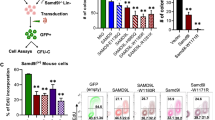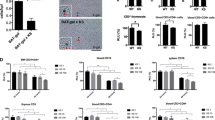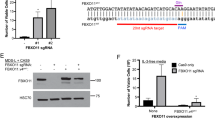Abstract
Shwachman-Diamond syndrome (SDS) is an autosomal recessive disorder characterized by exocrine pancreatic insufficiency and bone marrow failure. The depletion of SBDS protein by RNA interference has been shown to cause inhibition of cell proliferation in several cell lines. However, the precise mechanism by which the loss of SBDS leads to inhibition of cell growth remains unknown. To evaluate the impaired growth of SBDS-knockdown cells, we analyzed Epstein-Barr virus-transformed lymphoblast cells (LCLs) derived from two patients with SDS (c. 183_184TA > CT and c. 258 + 2 T > C). After 3 days of culture, the growth of LCL-SDS cell lines was considerably less than that of control donor cells. By annealing control primer-based GeneFishing PCR screening, we found that galectin-1 (Gal-1) mRNA expression was elevated in LCL-SDS cells. Western blot analysis showed that the level of Gal-1 protein expression was also increased in LCL-SDS cells as well as in SBDS-knockdown 32Dcl3 murine myeloid cells. We confirmed that recombinant Gal-1 inhibited the proliferation of both LCL-control and LCL-SDS cells and induced apoptosis (as determined by annexin V-positive staining). These results suggest that the overexpression of Gal-1 contributes to abnormal cell growth in SBDS-deficient cells.







Similar content being viewed by others
Data availability
The datasets generated and analyzed during the current study are available from the corresponding author on reasonable request.
References
Warren AJ. Molecular basis of the human ribosomopathy Shwachman-Diamond syndrome. Adv Biol Regul. 2018;67:109–27. https://doi.org/10.1016/j.jbior.2017.09.002.
Dror Y, Freedman MH. Shwachman-diamond syndrome. Br J Haematol. 2002;118(3):701–13.
Dror Y. Shwachman-Diamond syndrome. Pediatr Blood Cancer. 2005;45(7):892–901.
Makitie O, Ellis L, Durie PR, Morrison JA, Sochett EB, Rommens JM, Cole WG. Skeletal phenotype in patients with Shwachman-Diamond syndrome and mutations in SBDS. Clin Genet. 2004;65(2):101–12.
Toiviainen-Salo S, Durie PR, Numminen K, Heikkila P, Marttinen E, Savilahti E, Makitie O. The natural history of Shwachman-Diamond syndrome-associated liver disease from childhood to adulthood. J Pediatr. 2009. https://doi.org/10.1016/j.jpeds.2009.06.047.
Boocock GR, Morrison JA, Popovic M, Richards N, Ellis L, Durie PR, Rommens JM. Mutations in SBDS are associated with Shwachman-Diamond syndrome. Nat Genet. 2003;33(1):97–101.
Menne TF, Goyenechea B, Sanchez-Puig N, Wong CC, Tonkin LM, Ancliff PJ, et al. The Shwachman-Bodian-Diamond syndrome protein mediates translational activation of ribosomes in yeast. Nat Genet. 2007;39(4):486–95.
Finch AJ, Hilcenko C, Basse N, Drynan LF, Goyenechea B, Menne TF, et al. Uncoupling of GTP hydrolysis from eIF6 release on the ribosome causes Shwachman-Diamond syndrome. Genes Dev. 2011;25(9):917–29. https://doi.org/10.1101/gad.623011.
Stepanovic V, Wessels D, Goldman FD, Geiger J, Soll DR. The chemotaxis defect of Shwachman-Diamond Syndrome leukocytes. Cell Motil Cytoskeleton. 2004;57(3):158–74.
Dror Y, Freedman MH. Shwachman-Diamond syndrome marrow cells show abnormally increased apoptosis mediated through the Fas pathway. Blood. 2001;97(10):3011–6.
Austin KM, Gupta ML, Coats SA, Tulpule A, Mostoslavsky G, Balazs AB, et al. Mitotic spindle destabilization and genomic instability in Shwachman-Diamond syndrome. J Clin Invest. 2008;118(4):1511–8. https://doi.org/10.1172/JCI33764.
Ambekar C, Das B, Yeger H, Dror Y. SBDS-deficiency results in deregulation of reactive oxygen species leading to increased cell death and decreased cell growth. Pediatr Blood Cancer. 2010;55(6):1138–44. https://doi.org/10.1002/pbc.22700.
Leung R, Cuddy K, Wang Y, Rommens J, Glogauer M. Sbds is required for Rac2-mediated monocyte migration and signaling downstream of RANK during osteoclastogenesis. Blood. 2011;117(6):2044–53. https://doi.org/10.1182/blood-2010-05-282574.
Zhang S, Shi M, Hui CC, Rommens JM. Loss of the mouse ortholog of the shwachman-diamond syndrome gene (Sbds) results in early embryonic lethality. Mol Cell Biol. 2006;26(17):6656–63.
Yamaguchi M, Fujimura K, Toga H, Khwaja A, Okamura N, Chopra R. Shwachman-Diamond syndrome is not necessary for the terminal maturation of neutrophils but is important for maintaining viability of granulocyte precursors. Exp Hematol. 2007;35(4):579–86.
Rawls AS, Gregory AD, Woloszynek JR, Liu F, Link DC. Lentiviral-mediated RNAi inhibition of Sbds in murine hematopoietic progenitors impairs their hematopoietic potential. Blood. 2007;110(7):2414–22. https://doi.org/10.1182/blood-2006-03-007112.
Nihrane A, Sezgin G, Dsilva S, Dellorusso P, Yamamoto K, Ellis SR, Liu JM. Depletion of the Shwachman-Diamond syndrome gene product, SBDS, leads to growth inhibition and increased expression of OPG and VEGF-A. Blood Cells Mol Dis. 2009;42(1):85–91. https://doi.org/10.1016/j.bcmd.2008.09.004.
Yamaguchi M, Fujimura K, Kanegane H, Toga-Yamaguchi H, Chopra R, Okamura N. Mislocalization or low expression of mutated Shwachman-Bodian-Diamond syndrome protein. Int J Hematol. 2011;94(1):54–62. https://doi.org/10.1007/s12185-011-0880-1.
Camby I, Le Mercier M, Lefranc F, Kiss R. Galectin-1: a small protein with major functions. Glycobiology. 2006;16(11):137R-157R. https://doi.org/10.1093/glycob/cwl025.
Zambetti NA, Bindels EM, Van Strien PM, Valkhof MG, Adisty MN, Hoogenboezem RM, et al. Deficiency of the ribosome biogenesis gene Sbds in hematopoietic stem and progenitor cells causes neutropenia in mice by attenuating lineage progression in myelocytes. Haematologica. 2015;100(10):1285–93. https://doi.org/10.3324/haematol.2015.131573.
Lefranc F, Mathieu V, Kiss R. Galectin-1-mediated biochemical controls of melanoma and glioma aggressive behavior. World J Biol Chem. 2011;2(9):193–201. https://doi.org/10.4331/wjbc.v2.i9.193.
Hsieh SH, Ying NW, Wu MH, Chiang WF, Hsu CL, Wong TY, et al. Galectin-1, a novel ligand of neuropilin-1, activates VEGFR-2 signaling and modulates the migration of vascular endothelial cells. Oncogene. 2008;27(26):3746–53. https://doi.org/10.1038/sj.onc.1211029.
Stowell SR, Cho M, Feasley CL, Arthur CM, Song X, Colucci JK, et al. Ligand reduces galectin-1 sensitivity to oxidative inactivation by enhancing dimer formation. J Biol Chem. 2009;284(8):4989–99. https://doi.org/10.1074/jbc.M808925200.
Stowell SR, Qian Y, Karmakar S, Koyama NS, Dias-Baruffi M, Leffler H, et al. Differential roles of galectin-1 and galectin-3 in regulating leukocyte viability and cytokine secretion. J Immunol. 2008;180(5):3091–102.
Bi S, Earl LA, Jacobs L, Baum LG. Structural features of galectin-9 and galectin-1 that determine distinct T cell death pathways. J Biol Chem. 2008;283(18):12248–58. https://doi.org/10.1074/jbc.M800523200.
Dias-Baruffi M, Zhu H, Cho M, Karmakar S, McEver RP, Cummings RD. Dimeric galectin-1 induces surface exposure of phosphatidylserine and phagocytic recognition of leukocytes without inducing apoptosis. J Biol Chem. 2003;278(42):41282–93. https://doi.org/10.1074/jbc.M306624200.
Hahn HP, Pang M, He J, Hernandez JD, Yang RY, Li LY, et al. Galectin-1 induces nuclear translocation of endonuclease G in caspase- and cytochrome c-independent T cell death. Cell Death Differ. 2004;11(12):1277–86. https://doi.org/10.1038/sj.cdd.4401485.
Cedeno-Laurent F, Watanabe R, Teague JE, Kupper TS, Clark RA, Dimitroff CJ. Galectin-1 inhibits the viability, proliferation, and Th1 cytokine production of nonmalignant T cells in patients with leukemic cutaneous T-cell lymphoma. Blood. 2012;119(15):3534–8. https://doi.org/10.1182/blood-2011-12-396457.
Fischer C, Sanchez-Ruderisch H, Welzel M, Wiedenmann B, Sakai T, Andre S, et al. Galectin-1 interacts with the {alpha}5{beta}1 fibronectin receptor to restrict carcinoma cell growth via induction of p21 and p27. J Biol Chem. 2005;280(44):37266–77. https://doi.org/10.1074/jbc.M411580200.
Juszczynski P, Ouyang J, Monti S, Rodig SJ, Takeyama K, Abramson J, et al. The AP1-dependent secretion of galectin-1 by Reed Sternberg cells fosters immune privilege in classical Hodgkin lymphoma. Proc Natl Acad Sci USA. 2007;104(32):13134–9. https://doi.org/10.1073/pnas.0706017104.
Rodig SJ, Ouyang J, Juszczynski P, Currie T, Law K, Neuberg DS, et al. AP1-dependent galectin-1 expression delineates classical hodgkin and anaplastic large cell lymphomas from other lymphoid malignancies with shared molecular features. Clin Cancer Res. 2008;14(11):3338–44. https://doi.org/10.1158/1078-0432.CCR-07-4709.
Dror Y, Ginzberg H, Dalal I, Cherepanov V, Downey G, Durie P, et al. Immune function in patients with Shwachman-Diamond syndrome. Br J Haematol. 2001;114(3):712–7.
Acknowledgements
The authors declare that they have no conflict of interest. We would like to thank Dr. Tsuneo Imanaka (Hiroshima International University) for useful discussions. This study was supported in part by a Grant-in Aid for Blood Coagulation Abnormalities from the Ministry of Health, Labor, and Welfare of Japan. We thank Dr. Hisashi Kawashima (Tokyo Medical University) for providing the patient samples, and Ms. Chikako Sakai (University of Toyama) for technical assistance. This manuscript was edited by Pacific Edit.
Author information
Authors and Affiliations
Corresponding author
Additional information
Publisher's Note
Springer Nature remains neutral with regard to jurisdictional claims in published maps and institutional affiliations.
Supplementary Information
Below is the link to the electronic supplementary material.
12185_2024_3709_MOESM1_ESM.tiff
Supplementary file1 (TIFF 1142 KB) Supplementary Figure 1 rhGal-1 induced aggregation of 32Dcl3 cells. 32Dcl3 were cultured with 5 µM rhGal-1 in IMDM /10% FCS/10% conditioned medium and incubated at 37℃ for 2 days. The images are representation of at least 3 independent experiments
12185_2024_3709_MOESM2_ESM.tiff
Supplementary file2 (TIFF 1142 KB) Supplementary Figure 2 Cell cycle analysis of LCL cells. LCL cells were cultured at a density of 1 × 105 cells/mL in RPMI 1640/10% FCS medium and incubated at 37℃ for 3 days. Cells were fixed with 70% ethanol and stained with propidium iodide (PI). The fluorescence intensity of PI was measured with flow cytometry. Values shown are the averages of three separate experiments ± standard deviation of the mean
12185_2024_3709_MOESM3_ESM.tiff
Supplementary file3 (TIFF 1142 KB) Supplementary Table 1 List of candidate genes that changed the expression in LCL-SDS cells. The expression ratio of identified genes in LCL-SDS/LCL-C was compared relative to GAPDH, which was set as 1
About this article
Cite this article
Yamaguchi, M., Sera, Y., Toga-Yamaguchi, H. et al. Knockdown of the Shwachman-Diamond syndrome gene, SBDS, induces galectin-1 expression and impairs cell growth. Int J Hematol 119, 383–391 (2024). https://doi.org/10.1007/s12185-024-03709-z
Received:
Revised:
Accepted:
Published:
Issue Date:
DOI: https://doi.org/10.1007/s12185-024-03709-z




